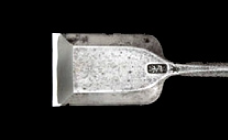Chisel [nomi]
Only
Only

Brim only
In the original part of the ear, there is a protruding part like a tsuba (two tsuba and one tsuba). It is used to drill holes for the injection of large nails into the member. After hitting the hole until it reaches an appropriate depth, tap the tsuba from below and pull it out. There are two blades and one blade.

Uchinuki
The cross section of the tip is rectangular. In the shape of the blade tip, there are streaks engraved vertically and horizontally on the plane, and the center part is cut into a V-shaped shape. When a hole is penetrated into the member, dig up to half from both sides with a ward chisel, etc., and then punch from one side by punch.

Only sore
The neck is warped and the tip is bent in the shape of a 'ku' shape. There is no crown on the pattern. Used to expose chips at the bottom of the hole.

Mori only
The blade tip is bent in a hook shape, and it is shaped like a harpoon that catches fish. Used to expose and finish cutting of holes.

Kama only
The blade tip is shaped like a long sword with two blades of a small sword. Used to finish sharp corners or to finish straight corners accurately.

Basic information
Special Exhibition
Permanent exhibition